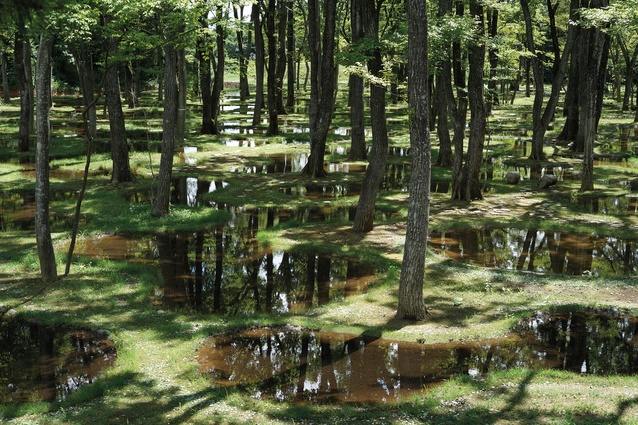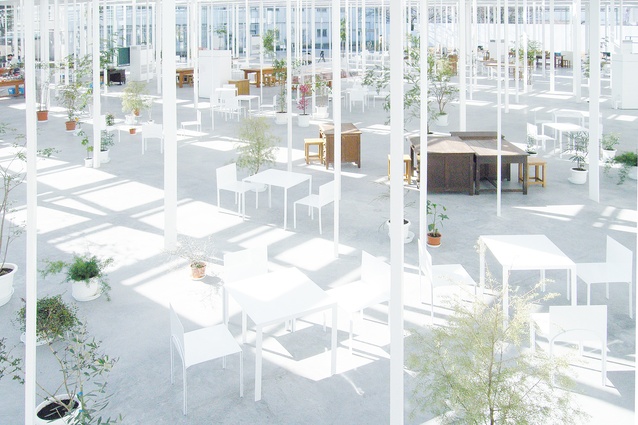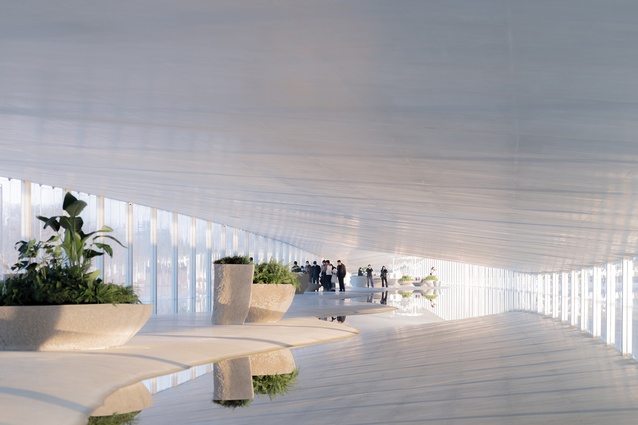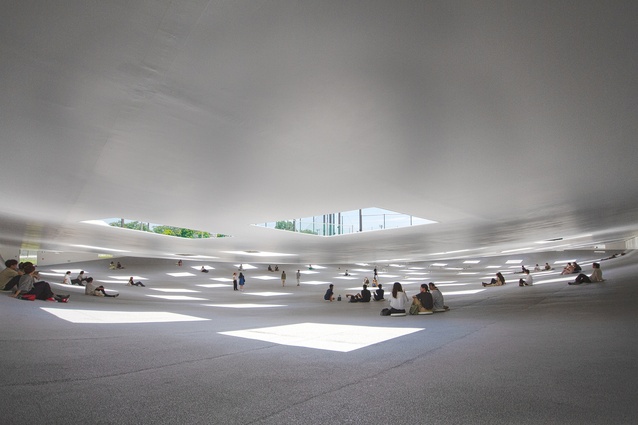The new natural
You’re never too long an architect to dream. Think back to those free-time sketches before discovering the constraints of budgets, expansion coefficients and insurance premiums: moments when you weren’t too deeply buried under stacks of practising certificates and built-up realities.
So, while you wait for those computer updates to load, why not grab a pencil and whimsy up an impossibly tree-d and pond-ed landscape, or a forest-columned office with people carrying their furniture around. Go on. Let roofs sag. Dig a new mould. There are worlds to discover. Snake that building for a kilometre across a lake and lift those walls to invite the water inside.
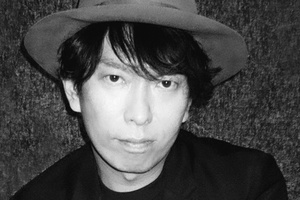
All a bit fanciful and better get back to the timesheet? There’s no purpose in whimsy, you say. But, wait, this is real: so real, it is constructed. Meet Japanese architect Junya Ishigami.
We are deep beneath Spark Arena, following Ishigami’s keynote at the Te Kāhui Whaihanga New Zealand Institute of Architects’ in:situ conference. It’s a strange locale: an empty room with painted concrete-block walls, low ceilings, a vinyl couch and a single chair in the middle. Banality perhaps perfect for pre-concert guitar swinging and a more-than-useful segway into a conversation with a true rock star of architecture. We laugh at the rather mundane interior environment in which we huddle and start talking about new relationships between architecture and landscape. “I want to make space like a landscape,” begins Ishigami. “I want to make a new environment between nature and man-made.”
We start with “space like a landscape” and it is not long before we are discussing a wandering-through-a-meadow-like relaxation of the usual space planning restrictions. This easing of space, Ishigami points out, is everywhere in nature and in the linking of inside and out that characterises much of Japanese architecture. We have spatial continuities down under, of course, visitable across the Tasman in SANAA’s recently opened Art Gallery of New South Wales Sydney Modern. Ishigami worked for SANAA before establishing Junya Ishigami and Associates in 2004, and there are similarities in the continuities but differences in their landscapes. “I want to create new ‘scenery’ in building.”
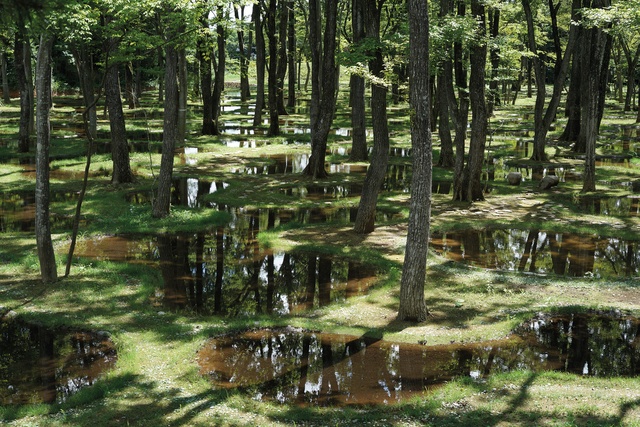
At many of the SANAA projects we have visited, we have found ourselves looking at the weeds growing around the buildings. We imagine the architects have let these grow as a way to accept reality. Ishigami laughs a simple reply: “No. No weeds.” He means it. At the Art Biotop Water Garden project in Tochigi, Japan, Ishigami’s gardening filled a meadow with small obloid-shaped ponds and literally moved a forest of trees into the leftover spaces between them. It’s a maddeningly beautiful endeavour that re-imagines the site’s rice paddy and forested past to make a landscape which could not exist without human intervention. “Is it a kind of environmental freeing of modernism?” “Yes” he smiles, “a new landscape that doesn’t exist in the natural world.” It requires specialist equipment to move full-grown trees but that wasn’t the start. There are pipes involved, with water taken and eventually returned to a nearby river, and the ponds have been individually waterproofed to allow this new constructed landscape to co-exist with nature. In a seemingly only-in-Japan moment, the garden remains weedless, winter, spring, summer and fall. Interestingly, architecturally making scenery doesn’t come with an evolutionary ‘natural selection’ specification. Not one we might expect from our usual approaches to external environments, anyway.
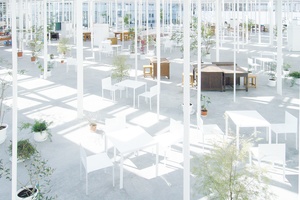
This “new natural” as Ishigami puts it, is paradoxical. It’s like realising whimsies or weedless gardening. Yet Ishigami pioneers this new world, with careful and considered purpose. It is Kenneth Frampton-style critical regionalism — being contextually located in a specific place and not anywhere else1 — yet entirely new at the same time. It isn’t constructed landscape masquerading as original, in the Western tradition of parks,2 for it is intently recognisable as architecture, and yet it isn’t entirely new either as it is also nature. This ambiguity is also apparent with Ishigami’s interiors, where he frees people to move through inside space as they might across a natural landscape. Forget just standing around the water cooler; at KAIT Workshop in Kanagawa, Japan, you can take your furniture with you and weave through a forest of slender steel columns on the way. The space is free: an interior environment with the openness of outside. Ishigami now stretches the enquiry to extremes, along with the structures with which it is built.
How far might this new natural extend? Ishigami pushes it out to the horizon. At his latest project at KAIT, the KAIT Plaza, he forms a space between a bowl-shaped ground-slab and a sky plane made of an incredulously thin, 20mm-thick metal sheet. This roof is cut full of holes and allowed to sag, with expansion coefficients meaning its height varies 300–400mm differentially between summer and winter, confounding the spatial horizon with variable volume, light and weather.
Can this new nature be old? Why not? At House & Restaurant, he formed a mould by burrowing into the ground and pouring in concrete. The ground was then dug out leaving the earth caked to the concrete to form a cavernous underground building where the new structural walls that support the interconnecting tunnelled space feel already old.
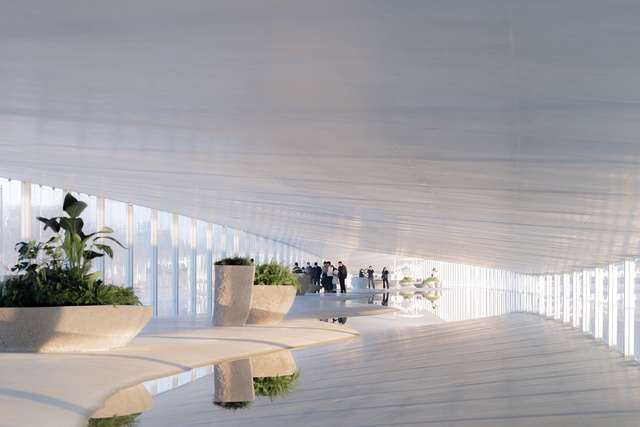
And now, most recently, at the Zaishui Art Museum in Rizhao, China, he winds a continuous space with a curving floor and ceiling for a full kilometre across a lake. And, just when you think you have seen it all, he lifts the perimeter glazing and allows the water inside to form what can only be described as an internal external landscape. The scenery is genius. So, too, are the mathematics and thinking. As for getting it all done, paradoxically that’s less whimsical.
Ishigami’s approach might have been seen initially as only-in-Japan architecture, given its extraordinary finesse and technical resolution. But, with projects now from America to Russia to China, Ishigami’s process of working the limits of local materialities and workforces seems strangely normalised. Equally, you have to look only at the theoretical studies which underpin the realities in Ishigami’s books — Another Scale of Architecture or Small Images, favourites of many students — to recognise an approach based on familiar architectural conventions where sketches, models, plans and sections draw out space.
Things in the interview are starting to feel a little real and, not wanting to end with expansion coefficients, we ask about his office, which we learn is a former discotheque located in the bar and restaurant scene in Roppongi, Tokyo, with “40 per cent space for people and 60 per cent space for models” — whimsically, the cardboard variety. “What’s pumping on the stereo?” This brings more rock-star amusement. “No music, quiet.” His is an architecture that is both life-as-we-know-it and not-as-we-know-it, all at the same time.
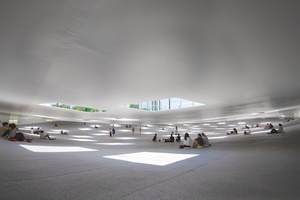
So, have a go at questioning the poetry buried in your sketches and look to the built environments in which we live. Whimsy without purpose? There’s no such thing. The extraordinary thing in Ishigami’s new natural is that his theoretical landscapes are no less whimsical than his constructed environments. Think to our shifting climates and fast-approaching horizons. Sustainability may yet come in many forms, and there is much to discover in a space between nature and architecture. It might just take Junya Ishigami, a new natural, and some collective whimsy to take us there.
References
1 Kenneth Frampton, ‘Towards a critical regionalism: Six points for an architecture of resistance’, in The Anti-Aesthetic: Essays on Postmodern Culture, edited by Hal Foster. Port Townsend, Washington: Bay Press, 1983.
2 For example: Frederick Olmsted’s American National Park landscapes; Anne Spirn, ‘Constructing nature: The legacy of Frederick Law Olmsted’, in Uncommon Ground: Toward Reinventing Nature, edited by William Cronon. New York: W. W. Norton & Co., 1995.


